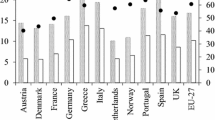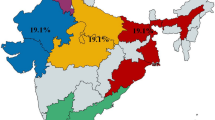Abstract
Latin America experienced a long period of sustained growth since 2003 that positively impacted social and labor market indicators, including poverty. This paper contributes to the understanding of this process as it carries out a comparative study of poverty dynamics in five Latin American countries during 2003–2008. It analyzes the extent to which countries with different levels of poverty incidence diverge in terms of poverty exit and entry rates, identifies the relative importance of the frequency and impact of events associated to poverty transitions and examines how these events affect households with different characteristics. For this, a dynamic analysis of panel data is carried out using regular household surveys. Sizeable rates of poverty movements were observed in all five countries and it was found that a large proportion of household experienced positive events, mainly related to the labor market; however, only a small fraction of them actually exited poverty. Demographic events and public cash transfers proved to be of little relevance; in particular, the latter did not contribute much either to intensify poverty exits or to prevent poverty entries. Households with children experienced more (less) negative (positive) events than those without children. It appeared therefore that even when the economy behaved reasonably well at the aggregate level, high levels of labor turnover and income mobility (even of a negative nature) still prevail, mainly associated to the high level of precariousness and the undeveloped system of social protection that characterize the studied countries.
Similar content being viewed by others
References
Aassve, A., Burgess, S., Propper, C., Dickson, M.: Modelling poverty by not modelling poverty: a simultaneous hazard approach to the UK. ISER Working Paper 2005–2026 (2005)
Arranz, J., Cantó, O.: The dynamics of poverty in Spain: the relevance of considering multiple-spells and their accumulation. The Society for the Study of Economic Inequality (ECINEQ) (2007)
Ballantyne, S., Chapple, S., Maré, D., Timmins, J.: Triggering movements into and out of child poverty: a comparative study of New Zealand, Britain and West Germany. Social Policy Journal of New Zealand, No. 22 (2004)
Bane, M., Ellwood, D.: Slipping into and out of poverty: the dynamics of spells. J. Hum. Resour. 21(1), 1–23 (1986)
Baulch, B., Hoddinott, J.: Economic mobility and poverty dynamics in developing countries. J. Dev. Stud. 36(6), 1–24 (2000)
Beccaria, L., Maurizio, R.: Factors associated to poverty mobility in greater Buenos Aires. Journal of Income Distribution. An International Quarterly, vol. 18, no. 2. New York University, Canada (2009)
Beccaria, L., Maurizio, R., Fernandez, A., Monsalvo, A., Álvarez, M.: Dynamics of poverty, labor market and public policies in Latin America. In: Report presented at the 8th Poverty and Economic Policy Research Network General Meeting. Dakar, Senegal (2010)
Biewen, M.: Who are the chronic poor? An econometric analysis of chronic poverty in Germany. Res. Econ. Inequal. 13, 31–62 (2006)
Cantó, O., Del Río, C., Gradín, C.: What helps households with children in leaving poverty? Evidence from Spain. Res. Econ. Inequal. 14, 1–29 (2007)
Cruces, G., Wodon, Q.: Transient and chronic poverty in turbulent times: Argentina 1995–2002. Econ. Bull. 9(3), 1–12 (2003)
Devicienti, F.: Poverty persistence in Britain: a multivariate analysis using the BHPS, 1991–1997. In: ISER Working Paper 2001–2002. University of Essex, Colchester (2001)
Economic Commission for Latin America and the Caribbean (ECLAC), Social Panorama of Latin America 2005. Santiago de Chile (2006)
Economic Commission for Latin America and the Caribbean (ECLAC), Social Panorama of Latin America 2010. Santiago de Chile (2010)
Elbers, C., Lanjouw, J., Lanjouw, P.: Micro-level estimation of poverty and inequality. Econometrica 71, 355–364 (2003)
Feres, J.: Notes on the measurement of poverty by the income method. CEPAL Rev. 61, 119–133 (1997)
Fields, G., Hernandez, R., Freije, S., Sanchez Puerta, M.: Intragenerationl income mobility in latin America. Economia 7(2), 101–154 (2007)
Glewwe, P.: How much of observed economic mobility is measurement error? IV methods to reduce measurement error bias, with an application to Vietnam. World Bank Econ. Rev. 26(2), 236–264 (2011)
Herrera, J., Roubaud, F.: Urban poverty dynamics in Peru and Madagascar. Int. Plan. Stud. 75(1), 70–95 (2007)
ILO: Bolsa Familia en Brasil: Contexto, Concepto e Impacto. Geneva (2009)
Jenkins, S., Rigg, J.: The dynamics of poverty in Britain. In: Department for Work and Pensions. Research Report No. 157 (2001)
Jenkins, S., Schluter, C.: Why are child poverty rates higher in Britain than in Germany? A longitudinal perspective. J. Hum. Resour. 35, 441–465 (2001)
Lee, N., Ridder, G., Strauss, J.: Estimation of poverty transition matrices with noisy data. Departamento de Economía, PUC, Río de Janeiro (2010)
Lillard, L., Willis, R.: Dynamic aspects of earnings mobility. Econometrica 46, 985–1012 (1978)
Machado, A., Perez Ribas, R.: Do changes in the labor market take families out of poverty? Determinants of exiting poverty in Brazilian metropolitan regions. J. Dev. Stud. 46(9), 1503–1522 (2010)
Maurizio, R., Perrot, B., Villafañe, S.: How important were social and labor market policies in reducing poverty across different families in Argentina? A dynamic approach. Journal of Income Distribution, An International Quarterly, vol. 18, no. 3–4. York University, Canada (2009)
McKernan, S., Ratcliffe, C.: Events that trigger poverty entries and exits. Soc. Sci. Q. 86(s1), 1146–1169 (2002)
Neilson, C., Contreras, D., Cooper, R., Hermann, J.: The dynamics of poverty in Chile. J. Lat. Am. Stud. 40, 251–273 (2008)
Paz, J.: Pobres pobres, cada vez más pobres. Una visión global de la pobreza. In: Maurizio, L.R. (ed.) Mercado de Trabajo y Equidad en Argentina. Beccaria, Prometeo Argentina (2005)
Perez Ribas, R., Machado, F.: Distinguishing chronic poverty from transient poverty in Brazil: developing a model for pseudo-panel data. International Poverty Centre Working Paper No. 46 (2007)
Perez Ribas, R., Soares, F.V., Hirata, G.: The Impact of CCTs. What we know and what we are not sure about. In: International Poverty Centre, Poverty in Focus “Cash Transfers. Lesson from Africa and Latin America”, Brazil (2008)
Perova, E., Vakis, R.: Welfare Impacts of the “Juntos” Program in Peru: Evidence from a Non-experimental Evaluation. The World Bank (2009)
Ravallion, M.: Poverty comparisons. The World Bank, Harwood Academic Publishers, Switzerland (1994)
Rio Group: Compendium of best practices in poverty measurement. Expert Group in Poverty Statistics. Rio de Janeiro (2006)
Ruggles, P., Williams, R.: Transitions in and out of poverty: new data from the survey of income and program participation. U.S. Department of Commerce, Bureau of the Census, SIPP Working Paper No. 8716. Washington (1987)
Sen, A.: Poor, relatively speaking. Oxf. Econ. Pap. 35, 153–169 (1983)
Sen, A.: A sociological approach to the measurement of poverty: a reply to professor Peter Townsend. Oxf. Econ. Pap. 37, 669–676 (1985)
Slon, P., Zúñiga, E.: Poverty Dynamics in Costa Rica with Panel Data from Cross-Sections. ECLAC Review No. 89 (2006)
Stevens, A.: Climbing out of poverty, falling back in. Measuring the persistence of poverty over multiple spells. J. Hum. Resour. 34, 557–588 (1999)
Veras Soares, F., Soares, S., Medeiros, M., Guerreiro Osório, R.: Cash transfer programmes in Brazil: Impacts on inequality and poverty. Working Paper No. 21. International Poverty Centre, UNDP/IPEA (2006)
Villatoro, P.: CCTs in Latin America: human capital accumulation and poverty reduction. In: International Poverty Centre, Poverty in Focus “Cash Transfers. Lesson from Africa and Latin America”. Brazil (2008)
Author information
Authors and Affiliations
Corresponding author
Electronic supplementary material
Below is the link to the electronic supplementary material.
Rights and permissions
About this article
Cite this article
Beccaria, L., Maurizio, R., Fernández, A.L. et al. Urban poverty and labor market dynamics in five Latin American countries: 2003–2008. J Econ Inequal 11, 555–580 (2013). https://doi.org/10.1007/s10888-012-9234-3
Received:
Accepted:
Published:
Issue Date:
DOI: https://doi.org/10.1007/s10888-012-9234-3




